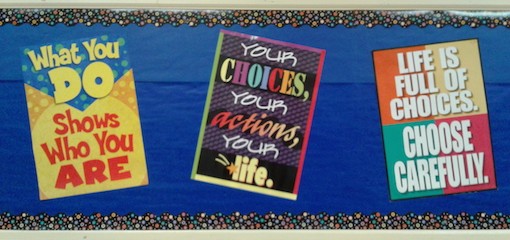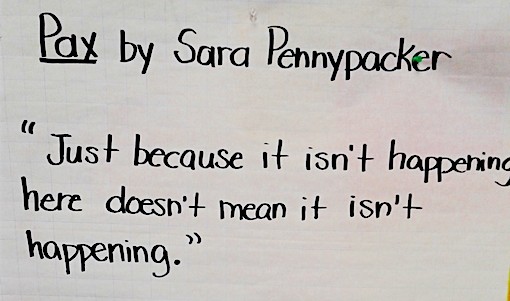Searching for Diversity in Our Suburban Class
A MiddleWeb Blog
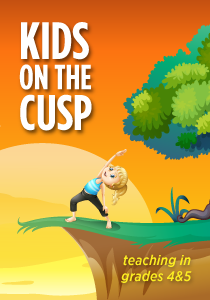
She had a large, mischievous grin on her face. “Hey Mom,” she quipped, “Do you know exactly what’s going to happen next year?”
I paused. I knew there must be a catch. “Hmmm,” I pondered aloud, before eventually conceding, “Honey, does anyone really know exactly what will happen an hour from now?… tomorrow? …next week? I have no idea what will happen next year.”
“You will in a few days,” she teased. “In a few days you’ll have 20-20 vision!”
I had to laugh. Now, there’s a punch line you won’t be able to use for much longer. Two weeks into 2020, however, I find myself thinking back to that moment in the hallway, trying to adjust my eyes to form a clearer vision for what lies ahead. Retrospect is 20/20. Looking forward, my vision of 2020 is not so clear.
The second half
By January, we are approaching the halfway mark in Classroom 4T. Half-way through the year, we know each other more as people. We have a little more background schema to work with. And we have developed a deeper level of trust, a comfortability with each other.
Halfway through the year, we’ve shared innumerable anecdotes about our personal lives, the settings and circumstances of our identities outside of the classroom. This is the essence of Social Emotional Learning.
Tricia Barvia, a fellow educator, lover of reading, and co-founder of #DisruptTexts discusses the importance of identity in an article entitled “We Teach Who We Are: Unpacking Our Identities.” She reminds us that “Teaching is an intensely human activity.”
Barvia observes that, “We bring all of our identities, and the experiences that inform them, into our teaching.” She asks herself an important question that we, as educators, should all be asking ourselves:
“If I don’t fully comprehend what impedes my own ability to understand racism as it exists in my own life, how can I teach students about racism with the complexity and knowledge required?”
Each member of 4T brings his or her own unique identity into our classroom. I am the teacher. I bring mine too.
Looking beyond privilege
We are diverse in many ways in 4T, but if you base the definition of diversity on the race indicator we would check off on a standardized form, we really aren’t very diverse. As a collective, 87% of my learners would check the “White” box. We (myself included) are growing up white in Suburbia, living what can quite easily be described as a privileged life.
Our economic statuses on a tax form may vary, but we have much more than most. And we live in the same school setting each day, so how do we learn about true diversity in the world outside of 4T? Winona Guo discusses the topic of teaching “Intentional Diversity” in her article “Toward a Culture of Racial Literacy”, published in May 2019 in the Harvard Political Review. In it, Guo discusses the importance of what Jasmine Waddell, Harvard’s former dean of first-year students, defines as “a historical and sociological framework to understand how oppression and privilege shape every part of our daily lives.”
I am charged with teaching the whole child and have been given the responsibility of discussing history as it impacts our lives today. Teaching historical, racial, and cultural literacy to a large group of impressionable minds is an integral part of my job, and I need to pay careful attention to exactly how I do that. I need to be aware that I bring my own biases and preconceptions into the classroom.
History lessons and selected read alouds
In 4T we are asking ourselves why people of different backgrounds experience conflict. We are trying to use multiple sources to gain a little perspective on unfamiliar cultures…to give us a bigger perspective on life outside of our classroom walls. In addition to Social Studies lessons, a careful selection of read alouds helps me accomplish this goal.
This year, for the fourth time, we are reading Sara Pennypacker’s war-torn novel, Pax. But this year, I am attempting to place a stronger emphasis on its setting. Pennypacker’s story opens with the quote, “Just because it isn’t happening here doesn’t mean it isn’t happening.” And exactly where does her story take place? What is the setting? That is the challenge I gave my readers this year, as we began reading.
Here’s the twist. There is no definitive setting in Pennypacker’s tale of war, loss, and unlikely friendships. The clues point toward somewhere in northern North America, but there is no exact location specified. And that is the bigger point I hope to make very clear this year as we read not only Pennypacker’s story, but the stories of different people from different places all over the world – while exploring a few hundred years of history – in our brief ten months together as a group.
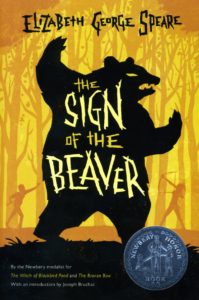
It’s 2020, but their story is just as impactful in understanding our essential question about conflict between diverse cultures. Neither boy embraces the challenges they are facing. But as each grows in maturity, understanding, and acceptance of the changing world around them. As each shares his own experience with the other, they discover much about themselves and their own, individual identities. That’s a valuable lesson for kids and adults alike.
It’s time to introduce my current circle of kids to an old story with a timeless message. Attean and Matt come from very different backgrounds, very different settings, not only from each other, but from all of the faces looking up at me from the rug each day.
Exploring the world outside together
If we are going to embrace the future, we need to have a good outlook…a vision about what we can do and who we want to be. When my students feel they are part of the small world that is our classroom, they grow both emotionally and socially. We explore the world outside together. We share our thoughts, and our diverse selves, as openly, honestly, and bravely as we can.
I know I can’t solve world peace, but I can do my part to help tomorrow’s decision-makers, and myself, become more historically, racially, and culturally literate. Hopefully, the conversations we have in the classroom will carry over into the conversations we have with other people, different people, in the world outside of 4T…and with the same level of openness, honesty and courage to share who we are.
There is a lot of conflict in the world out there. “Just because it isn’t happening here, doesn’t mean it isn’t happening.” Just turn on the news.
Here’s a look at some predictions for the year 2028
From the video: “The most valuable and fought-after resource will be…water….” Incidentally, that is what they are fighting over in Pennypacker’s Pax. Posted in 2014.
Resources for Teaching About Native American Heritage
The Story of Two Wolves by Alyssa Yeo, LPC, CYT, in Urban Balance
Native American Influences in U.S. History and Culture from Teaching Tolerance
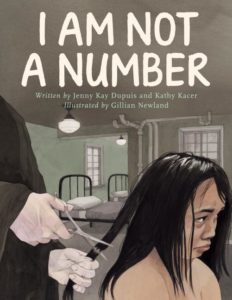
Connected to Everything: A story from the Bitterroot Salish by Jennifer Greene, from Teaching Tolerance
Uprooted: The 1950s plan to erase Indian Country from American Public Media
Pax Resources
Readers’ responses to Pax – Padlet
War Through a Child’s—and a Fox’s—Eyes: Sara Pennypacker on Her New Novel, Pax by Kiera Parrott from SLJ’s Under the Covers
Pax Book Unit by Gay Miller
Teaching Diversity ~ links and classroom resources
Teaching and Learning Conversation (TLC): Culturally Responsive Teaching – Created by Dr. Cheryl R Richardson for the University of Delaware Center for Teaching and Assessment of Learning
Teaching Tolerance – A Project of the Southern Poverty Law Center
Podcasts from Teaching Tolerance

